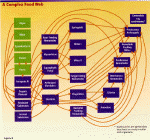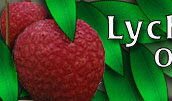The Soil Biology Primer
Chapter 2: THE FOOD WEB & SOIL HEALTH
By Elaine R. Ingham
HOW DO FOOD WEBS DIFFER?
Each field, forest, or pasture has a unique soil food web with a
particular proportion of bacteria, fungi, and other groups, and a
particular level of complexity within each group of organisms. These
differences are the result of soil, vegetation, and climate factors, as
well as land management practices. (See figure of food webs in different
ecosystems.)
TYPICAL FOOD WEB STRUCTURES
 The “structure” of a food web is the composition
and relative numbers of organisms in each group within the soil system.
Each type of ecosystem has a characteristic food web structure (see table
of typical numbers of organisms in soil). Some features of food web
structures include: The “structure” of a food web is the composition
and relative numbers of organisms in each group within the soil system.
Each type of ecosystem has a characteristic food web structure (see table
of typical numbers of organisms in soil). Some features of food web
structures include:
The ratio of fungi to bacteria is characteristic to the type of
system. Grasslands and agricultural soils usually have
bacterial-dominated food webs – that is, most biomass is in the form of
bacteria. Highly productive agricultural soils tend to have ratios of
fungal to bacterial biomass near 1:1 or somewhat less. Forests tend to
have fungal-dominated food webs. The ratio of fungal to bacterial biomass
may be 5:1 to 10:1 in a deciduous forest and 100:1 to 1000:1 in a
coniferous forest.
Organisms reflect their food source. For example,
protozoa are abundant where bacteria are plentiful. Where bacteria
dominate over fungi, nematodes that eat bacteria are more numerous than
nematodes that eat fungi.
Management practices change food webs. For example, in
reduced tillage agricultural systems, the ratio of fungi to bacteria
increases over time, and earthworms and arthropods become more
plentiful.
HOW IS THE FOOD WEB MEASURED?
The measurement techniques used to characterize a food web include:
Counting. Organism groups, such as bacteria, protozoa,
arthropods, etc.; or subgroups, such as bacterial-feeding, fungal-feeding,
and predatory nematodes, are counted and through calculations, can be
converted to biomass.
Direct counts – counting individual
organisms with the naked eye or with a microscope. All organisms can be
counted, or only the active ones that take up a fluorescent stain (Figure
3).
Plate counts – counting the number
of bacterial or fungal colonies that grow from a soil sample.
Measuring activity levels. Activity is determined by
measuring the amount of by-products, such as CO2, generated in the soil,
or the disappearance of substances, such as plant residue or methane used
by a large portion of the community or by specific groups of
organisms.
These measurements reflect the total “work” the community can do. Total
biological activity is the sum of activities of all organisms, though only
a portion are active at a particular time.
Respiration – measuring CO2
production. This method does not distinguish which organisms (plants,
pathogens, or other soil organisms) are generating the CO2.
Nitrification rates – measuring the
activity of those species involved in the conversion of ammonium to
nitrate.
Decomposition rates – measuring the
speed of disappearance of organic residue or standardized cotton
strips.
Measuring cellular constituents. The total biomass of
all soil organisms or specific characteristics of the community can be
inferred by measuring components of soil organisms such as the
following.
Biomass carbon, nitrogen, or
phosphorus – measure the amount of nutrients in living cells, which
can then be used to estimate the total biomass of organisms. Chloroform
fumigation is a common method used to estimate the amount of carbon or
nitrogen in all soil organisms.
Enzymes – measure enzymes in living
cells or attached to soil. Assays can be used to estimate potential
activity or to characterize the biological community.
Phospholipids and other lipids –
provide a “fingerprint” of the community, and quantify the biomass of
groups such as fungi or actinomycetes.
DNA and RNA – provide a
“fingerprint” of the community, and can detect the presence of specific
species or groups.
WHAT IS COMPLEXITY?
Food web complexity is a factor of both the number of species and the
number of different kinds of species in the soil. For example, a soil with
ten species of bacterial-feeding nematodes is less complex than a soil
with ten nematode species that includes bacterial-feeders, fungal-feeders,
and predatory nematodes.
 Complexity can be determined, in part, from a food
web diagram such as Figure 4 (see diagram), which represents the soil in
an old-growth Douglas fir forest. Each box of the food web diagram
represents a functional group of organisms that perform similar roles in
the soil system. Transfers of energy are represented by the arrows on the
diagram and occur when one organism eats another. Complex ecosystems have
more functional groups and more energy transfers than simple
ecosystems. Complexity can be determined, in part, from a food
web diagram such as Figure 4 (see diagram), which represents the soil in
an old-growth Douglas fir forest. Each box of the food web diagram
represents a functional group of organisms that perform similar roles in
the soil system. Transfers of energy are represented by the arrows on the
diagram and occur when one organism eats another. Complex ecosystems have
more functional groups and more energy transfers than simple
ecosystems.
The number of functional groups that turn over energy before the energy
leaves the soil system is different (and characteristic) for each
ecosystem (Figure 5). In the Douglas fir system (Figure 4), energy may
undergo more than twenty transfers from organism to organism, or between
functional groups. In contrast, a cave or low-residue cultivated system is
not likely to include a large variety of higher predators on the
right-hand side of a soil food web diagram. Energy and nutrients will be
cycled through fewer types of organisms.
Land management practices can alter the number of functional groups –
or complexity – in the soil. Intensively managed systems, such as
cropland, have varied numbers of functional groups. Crop selections,
tillage practices, residue management, pesticide use, and irrigation alter
the habitat for soil organisms, and thus alter the structure and
complexity of the food web.
BENEFITS OF COMPLEXITY
Biological complexity of a soil system can affect processes such as
nutrient cycling, the formation of soil structure, pest cycles, and
decomposition rates. Researchers have yet to define how much and what kind
of food web complexity in managed ecosystems is optimal for these soil
processes.
Nutrient cycling. When organisms consume food, they
create more of their own biomass and they release wastes. The most
important waste for crop growth is ammonium (NH4+). Ammonium and other
readily utilized nutrients are quickly taken up by other organisms,
including plant roots. When a large variety of organisms are present,
nutrients may cycle more rapidly and frequently among forms that plants
can and cannot use.
Nutrient retention. In addition to mineralizing or
releasing nitrogen to plants, the soil food web can immobilize or retain
nitrogen when plants are not rapidly growing. Nitrogen in the form of soil
organic matter and organism biomass is less mobile and less likely to be
lost from the rooting zone than inorganic nitrate (NO3-) and ammonium
(NH4+).
Improved structure, infiltration, and water-holding
capacity. Many soil organisms are involved in the formation and
stability of soil aggregates. Bacterial activity, organic matter, and the
chemical properties of clay particles are responsible for creating
microaggregates from individual soil particles. Earthworms and arthropods
consume small aggregates of mineral particles and organic matter, and
generate larger fecal pellets coated with compounds from the gut. These
fecal pellets become part of the soil structure. Fungal hyphae and root
hairs bind together and help stabilize larger aggregates. Improved
aggregate stability, along with the burrows of earthworms and arthropods,
increases porosity, water infiltration, and water-holding capacity.
Disease suppression. A complex soil food web contains
numerous organisms that can compete with disease-causing organisms. These
competitors may prevent soil pathogens from establishing on plant
surfaces, prevent pathogens from getting food, feed on pathogens, or
generate metabolites that are toxic to or inhibit pathogens.
Degradation of pollutants. An important role of soil
is to purify water. A complex food web includes organisms that consume
(degrade) a wide range of pollutants under a wide range of environmental
conditions.
Biodiversity. Greater food web complexity means
greater biodiversity. Biodiversity is measured by the total number of
species, as well as the relative abundance of these species, and the
number of functional groups of organisms.
MANAGEMENT AND SOIL HEALTH
A healthy soil effectively supports plant growth, protects air and
water quality, and ensures human and animal health. The physical
structure, chemical make-up, and biological components of the soil
together determine how well a soil performs these services.
In every healthy system or watershed, the soil food web is critical to
major soil functions including:
1) sustaining biological activity, diversity, and
productivity;
2) regulating the flow of water and dissolved
nutrients;
3) storing and cycling nutrients and other elements;
and
4) filtering, buffering, degrading, immobilizing and
detoxifying organic and inorganic materials that are potential
pollutants.
The interactions among organisms enhance many of these functions.
Successful land management requires approaches that protect all
resources, including soil, water, air, plants, animals and humans. Many
management strategies change soil habitats and the food web, and alter
soil quality, or the capacity of soil to perform its functions. Examples
of some practices that change the complexity and health of the soil
community include:
-
Compared to a field with a 2-year crop rotation, a field with a 4
crops grown in rotation may have a greater variety of food sources
(i.e., roots and surface residue), and therefore is likely to have more
types of bacteria, fungi, and other organisms.
-
A cleanly-tilled field with few vegetated edges may have fewer
habitats for arthropods than a field broken up by grassed waterways,
terraces, or fence rows.
-
Although the effect of pesticides on soil organisms varies, high
levels of pesticide use will generally reduce food web complexity. An
extreme example is the repeated use of methyl bromide which has been
observed to eliminate most soil organisms except a few bacteria species.
THE FOOD WEB AND CARBON SEQUESTRATION
Land management practices can be chosen to increase the amount of
carbon sequestered as soil organic matter and reduce the amount of CO2, a
greenhouse gas, released to the atmosphere.
As the soil food web decomposes organic material, it releases carbon
into the atmosphere as CO2 or converts it to a variety of forms of soil
organic matter. Labile or active fractions of organic matter stay in the
soil for a few years. Stable forms reside in the soil for decades or
hundreds of years. Physically stabilized organic matter is protected
inside soil aggregates that soil organisms help create. Humified organic
matter is stable because bacteria and fungi have helped form molecules
that are too complex and large for soil organisms to decompose.
LOOKING FORWARD
The functions of the food web are essential to plant growth and
environmental quality. Good resource management will integrate food
web-enhancing strategies into the regular activities of farms, ranches,
forests, or in backyard gardens. Needed research will examine food web
functions within whole systems, and will support technology development.
Technology to assess and maintain the functions of soil food webs will be
developed to assist land managers and researchers as they strive towards
soil productivity and stewardship. In the coming years, we can expect
progress at answering soil biology questions such as the following.
What is a healthy food web? What
measurements or observations can be used to determine whether a particular
biological community is desirable for the intended land use? What level of
complexity is optimal for highly productive and sustainable crop, range or
forest lands?
Is it more useful to count species, or types of organisms?
The Soil Biology Primer divides food web organisms into six
groups. Achieving an optimal balance of these groups is one approach to
managing the food web. Alternatively, identifying the species and
complexity present within a group may provide other useful information
about the health and productive potential of a soil.
How should the biology of the soil be
managed? In the future, land managers may be able to
more precisely predict the effect of management decisions such as the
timing of tillage, the application of a certain kind of compost, or the
use of a particular pesticide. They may choose practices with the intent
of making specific changes to the composition of the soil food web.
What are the costs and benefits of managing for soil
biological functions? The costs to achieve a highly diverse,
or complex, soil community need to be identified. These can be compared to
the benefits of biological services provided, such as nutrient cycling,
disease suppression, and soil structure enhancement.
Next
chapter: Soil Bacteria ->
<Return
to the Soil Biology Primer home page
Back To Lychee Info
|

